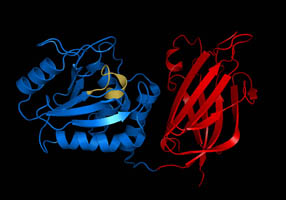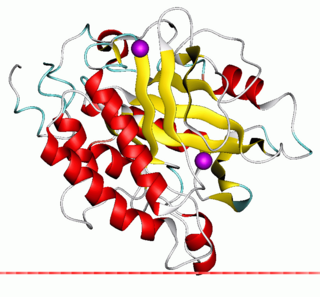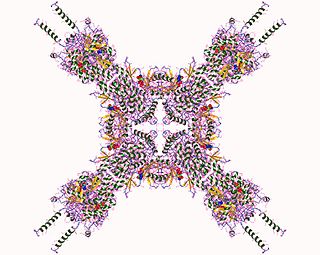Related Research Articles

Phosphoinositide phospholipase C is a family of eukaryotic intracellular enzymes that play an important role in signal transduction processes. These enzymes belong to a larger superfamily of Phospholipase C. Other families of phospholipase C enzymes have been identified in bacteria and trypanosomes. Phospholipases C are phosphodiesterases.

Phosphatase and tensin homolog (PTEN) is a phosphatase in humans and is encoded by the PTEN gene. Mutations of this gene are a step in the development of many cancers, specifically glioblastoma, lung cancer, breast cancer, and prostate cancer. Genes corresponding to PTEN (orthologs) have been identified in most mammals for which complete genome data are available.

Phosphatidylinositol (3,4,5)-trisphosphate (PtdIns(3,4,5)P3), abbreviated PIP3, is the product of the class I phosphoinositide 3-kinases' (PI 3-kinases) phosphorylation of phosphatidylinositol (4,5)-bisphosphate (PIP2). It is a phospholipid that resides on the plasma membrane.

Phosphatidylinositol (3,4)-bisphosphate is a minor phospholipid component of cell membranes, yet an important second messenger. The generation of PtdIns(3,4)P2 at the plasma membrane activates a number of important cell signaling pathways.

The enzyme phosphatidylinositol diacylglycerol-lyase catalyzes the following reaction:
The enzyme inositol-1,4-bisphosphate 1-phosphatase (EC 3.1.3.57) catalyzes the reaction

The enzyme Inositol phosphate-phosphatase is of the phosphodiesterase family of enzymes. It is involved in the phosphophatidylinositol signaling pathway, which affects a wide array of cell functions, including but not limited to, cell growth, apoptosis, secretion, and information processing. Inhibition of inositol monophosphatase may be key in the action of lithium in treating bipolar disorder, specifically manic depression.
The enzyme phosphatidylinositol-3,4-bisphosphate 4-phosphatase (EC 3.1.3.66) that catalyzes the reaction
The enzyme phosphatidylinositol-3-phosphatase (EC 3.1.3.64) catalyzes the reaction
The enzyme phosphoinositide 5-phosphatase (EC 3.1.3.36) catalyzes the reaction

In enzymology, a 1-phosphatidylinositol 4-kinase is an enzyme that catalyzes the chemical reaction
In enzymology, 1-phosphatidylinositol-4-phosphate 5-kinase is an enzyme that catalyzes the chemical reaction
In enzymology, a 1-phosphatidylinositol-5-phosphate 4-kinase is an enzyme that catalyzes the chemical reaction
In enzymology, an inositol-tetrakisphosphate 1-kinase is an enzyme that catalyzes the chemical reaction
In enzymology, a phosphatidylinositol-4,5-bisphosphate 3-kinase is an enzyme that catalyzes the chemical reaction:

Src homology 2 (SH2) domain containing inositol polyphosphate 5-phosphatase 1(SHIP1) is an enzyme with phosphatase activity. SHIP1 is structured by multiple domain and is encoded by the INPP5D gene in humans. SHIP1 is expressed predominantly by hematopoietic cells but also, for example, by osteoblasts and endothelial cells. This phosphatase is important for the regulation of cellular activation. Not only catalytic but also adaptor activities of this protein are involved in this process. Its movement from the cytosol to the cytoplasmic membrane, where predominantly performs its function, is mediated by tyrosine phosphorylation of the intracellular chains of cell surface receptors that SHIP1 binds. Insufficient regulation of SHIP1 leads to different pathologies.
The Akt signaling pathway or PI3K-Akt signaling pathway is a signal transduction pathway that promotes survival and growth in response to extracellular signals. Key proteins involved are PI3K and Akt.
Bisphosphate may refer to:
Phosphatidylinositol-4,5-bisphosphate 4-phosphatase (EC 3.1.3.78, phosphatidylinositol-4,5-bisphosphate 4-phosphatase I, phosphatidylinositol-4,5-bisphosphate 4-phosphatase II, type I PtdIns-4,5-P2 4-Ptase, type II PtdIns-4,5-P2 4-Ptase, IpgD, PtdIns-4,5-P2 4-phosphatase type I, PtdIns-4,5-P2 4-phosphatase type II, type I phosphatidylinositol-4,5-bisphosphate 4-phosphatase, type 1 4-phosphatase) is an enzyme with systematic name 1-phosphatidyl-1D-myo-inositol-4,5-bisphosphate 4-phosphohydrolase. This enzyme catalyses the following chemical reaction
Phosphatidylinositol-3,4,5-trisphosphate 5-phosphatase is an enzyme with systematic name 1-phosphatidyl-1D-myo-inositol-3,4,5-trisphosphate 5-phosphohydrolase, that has two isoforms: SHIP1 and SHIP2 (INPPL1).
References
- Kabuyama Y, Nakatsu N, Homma Y, Fukui Y (1996). "Purification and characterization of the phosphatidylinositol-3,4,5-trisphosphate phosphatase in bovine thymus". Eur. J. Biochem. 238 (2): 350–6. doi: 10.1111/j.1432-1033.1996.0350z.x . PMID 8681945.
- Maehama T, Dixon JE (1998). "The tumor suppressor, PTEN/MMAC1, dephosphorylates the lipid second messenger, phosphatidylinositol 3,4,5-trisphosphate". J. Biol. Chem. 273 (22): 13375–8. doi: 10.1074/jbc.273.22.13375 . PMID 9593664.